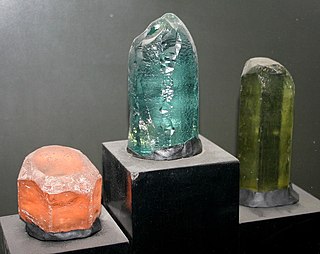
Beryl ( BERR-əl) is a mineral composed of beryllium aluminium silicate with the chemical formula Be3Al2Si6O18. Well-known varieties of beryl include emerald and aquamarine. Naturally occurring, hexagonal crystals of beryl can be up to several meters in size, but terminated crystals are relatively rare. Pure beryl is colorless, but it is frequently tinted by impurities; possible colors are green, blue, yellow, pink, and red (the rarest). It is an ore source of beryllium.

A gemstone is a piece of mineral crystal which, in cut and polished form, is used to make jewelry or other adornments. However, certain rocks and occasionally organic materials that are not minerals are also used for jewelry and are therefore often considered to be gemstones as well. Most gemstones are hard, but some soft minerals are used in jewelry because of their luster or other physical properties that have aesthetic value. Rarity and notoriety are other characteristics that lend value to gemstones.

Topaz is a silicate mineral of aluminium and fluorine with the chemical formula Al2SiO4(F,OH)2. It is used as a gemstone in jewelry and other adornments. Common topaz in its natural state is colorless, though trace element impurities can make it pale blue or golden brown to yellow orange. Topaz is often treated with heat or radiation to make it a deep blue, reddish-orange, pale green, pink, or purple.
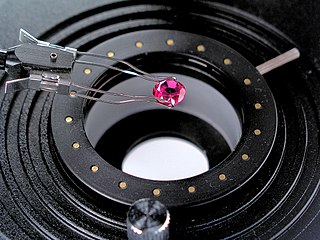
Gemology or gemmology is the science dealing with natural and artificial gemstone materials. It is a geoscience and a branch of mineralogy. Some jewelers are academically trained gemologists and are qualified to identify and evaluate gems.

The Field Museum of Natural History (FMNH), also known as The Field Museum, is a natural history museum in Chicago, Illinois, and is one of the largest such museums in the world. The museum is a popular natural-history museum for the size and quality of its educational and scientific programs, as well as due to its extensive scientific-specimen and artifact collections. The permanent exhibitions, which attract up to two million visitors annually, include fossils, current cultures from around the world, and interactive programming demonstrating today's urgent conservation needs. The museum is named in honor of its first major benefactor, the department-store magnate Marshall Field. The museum and its collections originated from the 1893 World's Columbian Exposition and the artifacts displayed at the fair.
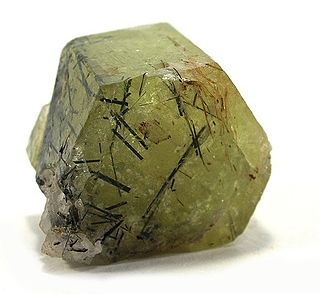
In mineralogy, an inclusion is any material that is trapped inside a mineral during its formation. In gemology, an inclusion is a characteristic enclosed within a gemstone, or reaching its surface from the interior.
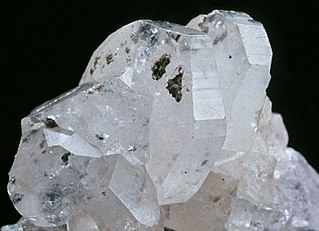
Phenakite or phenacite is a fairly rare nesosilicate mineral consisting of beryllium orthosilicate, Be2SiO4. Occasionally used as a gemstone, phenakite occurs as isolated crystals, which are rhombohedral with parallel-faced hemihedrism, and are either lenticular or prismatic in habit: the lenticular habit is determined by the development of faces of several obtuse rhombohedra and the absence of prism faces. There is no cleavage, and the fracture is conchoidal. The Mohs hardness is high, being 7.5 – 8; the specific gravity is 2.96. The crystals are sometimes perfectly colorless and transparent, but more often they are greyish or yellowish and only translucent; occasionally they are pale rose-red. In general appearance the mineral is not unlike quartz, for which indeed it has been mistaken. Its name comes from Ancient Greek: φέναξ, romanized: phénax, meaning "deceiver" due to its close visual similarity to quartz, named by Nils Gustaf Nordenskiöld in 1833.

The Logan Sapphire is a 422.98-carat (84.596 g) sapphire from Sri Lanka. One of the largest blue faceted sapphires in the world, it was owned by Sir Victor Sassoon and then purchased by M. Robert Guggenheim as a gift for his wife, Rebecca Pollard Guggenheim, who gifted the sapphire to the Smithsonian Institution in 1960. The sapphire's name is derived from Rebecca's new surname after she later married John A. Logan. It has been on display in the National Gem Collection of the National Museum of Natural History in Washington, D.C., since 1971. It is a mixed cushion-cut sapphire, approximately the size of a large chicken egg, and set in a silver and gold brooch surrounded by 20 round brilliant cut diamonds.

The Eagle Diamond is a gemstone discovered in Eagle, Wisconsin in 1876. It was one of more than a dozen rare gems stolen in a heist from the American Museum of Natural History in 1964 and remains missing to this day.

The American Golden Topaz, a 172-faceted topaz weighing 22,892.5 carats (4.57850 kg), is the largest cut yellow topaz in the world, and one of the largest faceted gems of any type in the world. Originating from Minas Gerais, Brazil, it was cut by Leon Agee over a period of two years from an 11.8 kg stream-rounded cobble owned by Drs. Marie L. and Edgar F. Borgatta. It was contributed jointly by the Borgatta owners and by Rockhound Hobbyists of America to the Smithsonian Institution in 1988 and is displayed in the National Museum of Natural History in Washington, D.C.
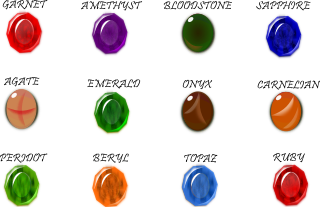
A birthstone is a gemstone that represents a person's period of birth that is usually the month or zodiac sign. Birthstones are often worn as jewelry or as a pendant necklace.
The gemstone irradiation is a process in which a gemstone is artificially irradiated in order to enhance its optical properties. High levels of ionizing radiation can change the atomic structure of the gemstone's crystal lattice, which in turn alters the optical properties within it. As a result, the gemstone's color may be significantly altered or the visibility of its inclusions may be lessened. The process, widely practised in jewelry industry, is done in either a nuclear reactor for neutron bombardment, a particle accelerator for electron bombardment, or a gamma ray facility using the radioactive isotope cobalt-60. Irradiation has enabled the creation of gemstone colors that do not exist or are extremely rare in nature.

ICT Incorporated, operating under the trade name the Shelby Gem Factory, was a Michigan company that manufactured artificial gemstones through proprietary processes. The factory made more varieties of man-made gemstones than any other in the world. It grew artificial gems and gem simulants, including synthetic ruby and sapphire and simulated diamonds, citrine, topaz, and other birthstone substitutes, and mounted them in gold or silver jewelry.

Roger Lansing Grande, more commonly known as Lance Grande, is an evolutionary biologist and curatorial scientist. His research and work is focused on Paleontology, Ichthyology, Systematics and Evolution. He is best known for his work on the paleontology of the Green River Formation and for his detailed monographs on the comparative anatomy and evolution of ray-finned fishes.
The Allison and Roberto Mignone Halls of Gems and Minerals are a series of exhibition halls at the American Museum of Natural History on the Upper West Side in Manhattan, New York City. The halls opened on June 12, 2021, as a complete redesign of their predecessors, the Harry Frank Guggenheim Hall of Gems and Minerals and Morgan Memorial Hall of Gems. The halls feature thousands of rare gems, mineral specimens and pieces of jewelry.
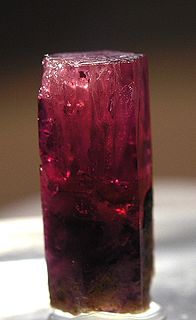
Red beryl, formerly known as bixbite and marketed as red emerald or scarlet emerald, is an extremely rare variety of beryl as well as one of the rarest minerals on Earth. The gem gets its red color from manganese ions embedded inside of beryllium aluminium cyclosilicate crystals. The color of red beryl is stable up to 1000 degrees. Red Beryl can come in various tints like strawberry, bright ruby, cherry, and orange.

Aquamarine is a pale-blue to light-green variety of beryl. The color of aquamarine can be changed by heat.















